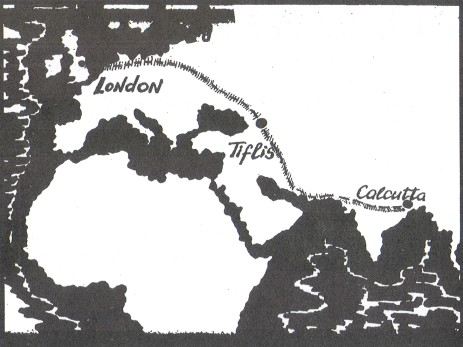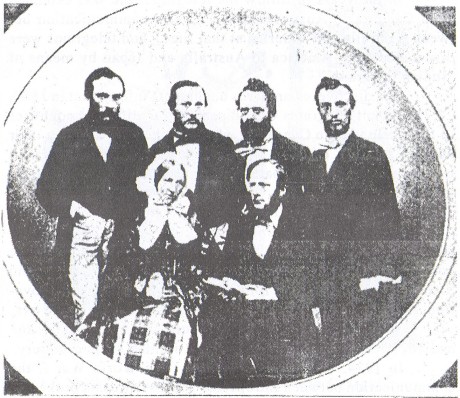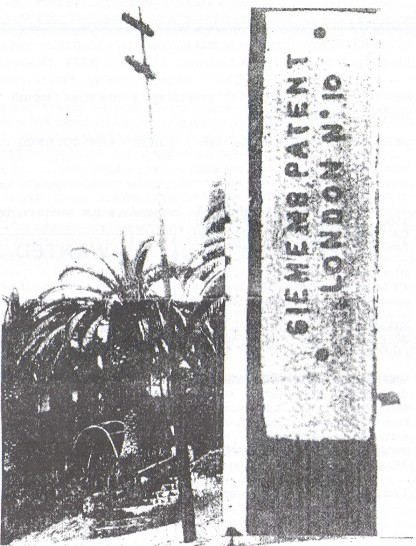The Indo-European Telegraph Via Caucasus
Reprinted from "Crown Jewels of the Wire", May 1996, page 15
by Andre Karbelashvili
The First Deputy Minister of Communications
of the Republic of Georgia
A thin metal post with the English inscription “Siemens London Patent”
stands on the beach of a picturesque Black Sea resort Gagra (Georgia). Guests
often wonder: how did it turn up here? The origin of this post is equally
mysterious both to the visitor and the experts on communication. When asked they
just shrug their shoulders and say: “Here for ages.”
To be more exact, it appeared here in 1869. And, of course, nobody can
imagine that the wires supported by this metal pillar “carried” telegrams to
faraway Calcutta from London and Geneva, Budapest and Prague, Petersburg and
Paris, Stockholm and Berlin, Vienna and Oslo, New York and Rome. Thirty-four
countries of the world exchanged telegrams with India via this modest
telegraph-post in Gagra. Eleven thousand of such posts were shipped from London
to the Caucasus and Persia to support wires of the world’s longest
Indo-European telegraph line.
On January 11, 1890 a festive dinner was given on the occasion of putting the
Indo-European telegraph into operation. Representatives of Georgian social
organizations, including those who supervised the construction of the telegraph
system in the Caucasus were present. Glasses were raised in honor of the Siemens
brothers, who were in charge of the construction of the telegraph line from
England to India.
The Indo-European telegraph stretched as long as 8300 km and functioned for
60 years. It played an important part in the development of the world’s
telegraph system. Even today, telegraph posts and buildings specially
constructed for the Indo-European telegraph remain in some parts of Georgia.

Numerous documents on the construction and operation of this telegraph,
materials about the activities of the Siemens brothers--Verner, Walter, Otto,
Karl and William who had visited Georgia at various dates in connection with the
construction of the first telegraph lines in the Caucasus (Tiflis-Kutaissi-Poti,
Dzhulfa, Tiflis-Baku) were found in the Central State historical Archives of
Georgia.
As soon as the first telegraph lines had appeared in the world, the
communication specialists faced a task--how to establish telegraph communication
from Europe with the faraway India. In 1861, when the telegraph line from Europe
reached Constantinople, construction of the Constantinople-Baghdad telegraph
began. The line, then was extended to Fao, located in the Persian Gulf. The
Indian government suggested a submarine telegraph cable between Karachi, Bashir,
Fao and in 1865 telegrams from Europe to Calcutta were dispatched via
Constantinople, Baghdad, Fao, Bushir and Karachi. Though the transmission took 6
days, 8 hours and 44 minutes, which by modern standards is, of course, very
long, still it was a great technical achievement, especially when compared with
the month-long mail delivery.
However, Verner Siemens, the renown German inventor, and subsequently a
member of the Berlin Academy of Sciences, was of a different opinion. The great
experience in the construction of telegraph lines prompted him that a line from
Europe to India had to be constructed along another route, namely via Russia and
Caucasus.
William Siemens decided to assist his brother in this undertaking--to
manufacture the submarine telegraph cable at his London factory and to lay it in
the Black Sea.
In November 1867 concession terms concerning construction of the Indian
telegraph were published in the Caucasian newspapers. The Siemens brothers were
granted the permission from Russian, Persian and Prussian governments.

Siemens Brothers: From left to right: Walter (died in 1868 in
Tbilisi),
Karl, Verner, Otto (died in 1871 in Tbilisi).
Sitting: William Siemens.
Telegrams from Europe to India were “to travel” by the following route:
London-submarine cable through the north Sea to
Emden-Berlin-Warsaw-Zhitomir-Berdichev-Vinnitsa-Yalta-Odessa-Kerch-submarine
cable in the Black
Sea-Sukhumi-Tiflis-Erevan-Dzhulfa-Tabris-Teheran-Bushir-Karachi-Calcutta.
The construction of the “Indian Telegraph” began in 1868 and continued
intensively in 1869. Posts had been erected everywhere from Zugdidi (West
Georgia) to Tiflis and used for suspending wires. In Georgia, this construction
was followed with great interest and in many cases the local authorities
rendered all kinds of assistance to the builders.
Putting the longest land telegraph line into operation was of great
importance for the development of the World’s telegraph system, as the
telegraph communication existing previously between Europe and India had been
entirely unreliable. The new telegraph allowed India to exchange telegrams via
the Caucasus with nearly every corner of the world.
In the years to follow the telegraph line was extended from Calcutta to
Australia (there was no communication between Australia and America at that
time), and telegrams were dispatched from America to Australia and Japan by
means of “Indian telegraph.”
The discovered archives documents inform that in 1880, 42,719 transit
telegrams were dispatched to different countries of the world via the Caucasus,
while for the entire Russia their number reached only 67,144. Thus 63 per cent
of transit telegrams have been dispatched by means of the “Indian telegraph.”
Electric signals “travelled” for many years by the telegraph post set up
on the Gagra beach to many countries of the world. And the inscription “Siemens
Patent London” on the post reminds us that this post was manufactured in
London and Siemens received a patent for its design as the technical innovation.
Today the post carries intra-town communication wires.
Walter Siemens and Otto Siemens died in Tbilisi in 1868 and 1871
respectively, and were buried in the same cemetery.
In 1914, with the beginning of the World War I, the communication between
Europe and India via Russia broke off. It was restored in 1923 in the USSR and
functioned until 1930.
The Indo-European telegraph played an important part in information exchange
between many countries of the world and in its time was considered to be a magnificent
technological achievement. The world’s longest transcontinental
telegraph line started the tradition of setting up transit links between the
countries and demonstrated the possibility of closer relations between the
nations.

Indo-European line telegraph post in Georgia.
§ Article from June 1991 The Georgian Independent, an
English language newspaper published in Tbilisi, Republic of Georgia and sent in
for reprinting by Don Fiene, Knoxville, Tennessee.
| 